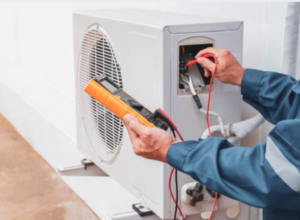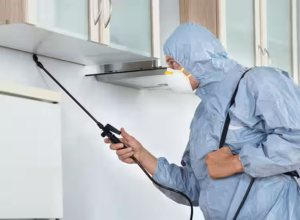Hvac Lexington systems do much more than heat or cool your home when you press a button. They also filter the air circulating through your home, property, or business.
They can help reduce the spread of infections like MRSA and Clostridium difficile spores in hospitals by regulating temperature, carbon dioxide concentration, and airflow rates. They can also improve energy efficiency and comfort.

Ventilation is one of the most important components of an HVAC system. It allows fresh air to circulate throughout a building, reducing humidity and contaminants. It also helps reduce dust and mold infiltration. There are many different types of mechanical ventilation systems, each with its own set of benefits. Some are designed for dry climates, others for humid ones, and still others for cold climates. Choosing a ventilation system that meets the needs of your work environment.
While most buildings used to have ample natural ventilation due to gaps and cracks in their construction, newer homes are much more tightly sealed, making mechanical ventilation systems necessary. These systems aim to bring in outdoor air through ducts and into an air handling unit, where it can be filtered and distributed to other spaces within the building.
In addition to improving indoor air quality, these systems help control moisture, odors, pollutants, and excess heat. They can also be used to exhaust fumes during renovation or other activities that might introduce contaminants into the workplace.
Ventilation can also be improved by upgrading filters and implementing energy recovery ventilators (ERVs) or heat recovery ventilators (HRVs). These systems can precondition incoming outdoor air to prevent excessive moisture, a common problem in schools.
Choosing the right filter for a ventilation system is essential to ensuring optimal performance. Filters with a high surface area are more effective at trapping airborne particles, including pollen, pet dander, bacteria, and viruses. Changing these filters regularly is essential for maintaining optimal air quality and preventing the circulation of contaminated air.
The main components of an HVAC system are the thermostat, the furnace, and the air handler. The thermostat controls the space’s temperature and signals the HVAC system to heat or cool the space as needed to maintain that temperature. The furnace creates heat by burning fuel, such as natural gas or propane, and the air handler distributes it evenly to rooms.
Heating
HVAC systems are designed to meet a building’s needs for thermal comfort, indoor air quality, and humidity control. This can be achieved through an air conditioner, furnace or heat pump, ductwork, thermostat, and other units like a humidifier or air cleaner. Ideally, the system will be properly sized for the space and designed to provide acceptable indoor air temperatures in all seasons.
Depending on the type of heating system, it can be central or ductless. The most common central heating solutions are furnaces and heat pumps. Both burn natural gas or other fuels to distribute heat throughout the property. Boilers are less common for residential properties because they heat water rather than distributing hot air to different rooms.
A key factor in the design of a good HVAC system is ensuring that it will be easy to maintain and repair. This includes making sure all components are easily accessible. For example, AHUs (air handling units) and their controls should not require a ladder or the removal of ceiling tiles to gain access. The same should apply to exhaust fans. It is also important to make sure that all ductwork has easy-to-open doors and that all vents are clear of obstructions.
In addition, HVAC equipment should be clearly labeled. This will help facilities personnel identify and understand how each component works. It will also allow them to perform maintenance and repairs quickly and efficiently. The labels should be visible when standing next to the equipment and durable enough to last the life of the unit.
The lifespan of HVAC equipment can vary depending on how well it is maintained. In general, high-use systems wear out after about a decade. However, if they are well-maintained, they may be able to keep working for much longer.
If your HVAC system is over 10 years old, it is a good idea to consider replacing it. This will save energy costs and improve the comfort of your home. You can also reduce your energy costs by upgrading to more efficient technology. In fact, investing in an efficient HVAC system can actually boost the value of your property.
Cooling
The cooling portion of an HVAC system helps control the temperature of the circulating air. It can be accomplished in a number of ways, depending on the specific needs of each space. For example, an industrial cooling system might use large fans to cool down the conditioned air that is then pumped through the building via ductwork. A commercial building’s HVAC system might also include chilled water for heating and cooling purposes, as well as systems that use humidity monitoring and control to provide optimal comfort.
The term HVAC encompasses many different heating and cooling products, including furnaces, air conditioners and heat pumps. It also refers to ductwork, thermostats, and other home comfort controls. The world of home heating and cooling can seem confusing to many homeowners. However, it doesn’t have to be. By learning about HVAC costs, key terms, products, and basic maintenance schedules, homeowners can feel more comfortable with the entire process.
An HVAC system is a complex network of units that work together to regulate indoor temperatures. They start with a thermostat, which determines the desired temperature inside a home or building. The thermostat signals the other HVAC components to begin warming or cooling the air, which is then circulated throughout the building. The cooled or warmed air is then distributed through the building’s ductwork, or via an air handler in homes without a ductwork system.
Whether your house has ductwork or not, the right heating and cooling system can make all the difference in your energy bills and level of comfort. If you’re shopping for a new HVAC system, speak with a Bryant Factory Authorized Dealer to learn more about the home heating and cooling options that might be best for your unique needs and lifestyle.
Many people get confused about the differences between an HVAC unit and an AC (air conditioning) unit. Contractors and builders often use the two terms interchangeably, but there is a definitive distinction between them. An HVAC unit heats, ventilates and cools the air in your home, while an AC unit only cools the air.
Filtration
Air filters are a critical component of HVAC systems, improving indoor air quality and extending the life of system components. They work by trapping and holding various types of particulates and contaminants — including dust, pet dander, mold spores, and bacteria — and then preventing them from recirculating. By doing this, HVAC filters protect the health and safety of people inside occupied spaces as well as the equipment itself.
The best HVAC filter for you will depend on your specific needs and environment. For example, if you have pets or smoke cigarettes in your home, you’ll need a stronger filter than someone without these issues. In addition, the type and size of air particulates that you’re trying to capture will also influence which filter type is best for you. You’ll likely notice that your HVAC filters are labeled with a P and a number (Particulate Matter) as well as a micron measurement. The number represents the filter’s effectiveness at capturing micron-sized particles.
Fiberglass filters are typically the least expensive type of HVAC filter. They are made from layered fiberglass that is designed to capture large particles, such as dust and dirt. These types of filters do not, however, do a great job of removing smaller pollutants, such as pollen and pet dander, making them ineffective for those with allergies or respiratory illnesses.
Filters with higher MERV ratings are more effective at reducing the size of airborne contaminants. However, higher MERV ratings also create more resistance to airflow, which can lead to increased energy use in the HVAC system.
For this reason, it’s important to balance your HVAC filter’s performance against its cost and energy efficiency. Fortunately, there are several ways to save on the cost of your filters while maximizing their performance. For example, you can purchase washable filters, which allow for multiple uses and are available in a variety of sizes. However, it’s crucial to follow the maintenance instructions carefully so that the filters don’t become clogged with mildew or mold and release these contaminants into the air you breathe. Alternatively, you can install extended media filters. These are much thicker than traditional flat filters, at about 8 inches in length and width.
